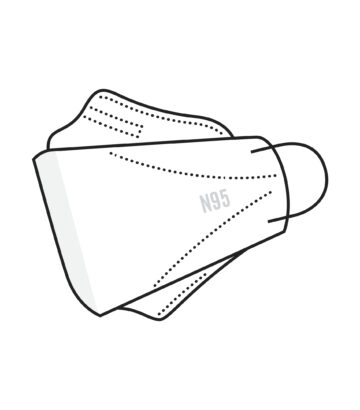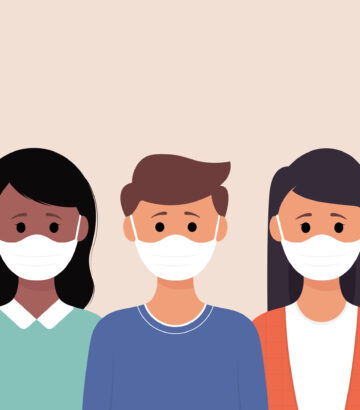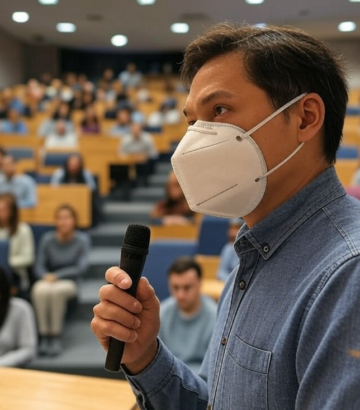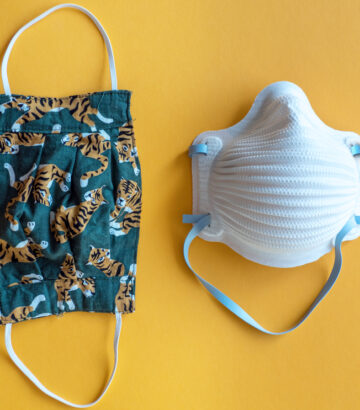WHN joins in the chorus: Medical masks are not PPE
Overview
Throughout the COVID pandemic, there has been confusion from public health and medical leaders over which masks to wear to prevent transmission of the SARS-CoV-2 virus. Inadequate supplies of respirator masks and a misunderstanding that the predominant means of transmission of disease was contact/droplet rather than the correct airborne/aerosol meant that there were recommendations for simple masks for both the public (e.g., cloth) and Health Care Workers (HCWs), (e.g., medical masks). Even now, as adequate supplies have long returned to the world, recommendations have improved for the public to use “well-fitted, well-constructed” respirator masks, while HCWs in many countries continue to use medical masks to protect themselves against respiratory illnesses.
Importantly, two national organizations have recently clarified—consistent with longstanding scientific and regulatory understanding—that medical masks (MMs) (also known as procedure or surgical masks) are not personal protective equipment (PPE). This is supported by substantial evidence extending back decades, which, however, has been persistently disregarded by healthcare facilities such as hospitals and long term care homes. But as many occupational hygienists and airborne scientists have pointed out throughout the pandemic, the only true and legal PPE to protect the user from airborne hazards (including infectious pathogens) is a respirator mask.
In August 2025 the British Occupational Hygiene Society released a statement rather awkwardly titled “Guidance for Healthcare Employers and Workers on the Use of Fluid-Resistance Surgical Masks and Respirators To Comply with the Requirements of the Control of Substances Hazardous to Health Regulations (COSHH) 2022 (England)” which reiterated the distinction between the masks, going so far as to say that it is a breach of Health and Safety law for employers to suggest that MMs could be used by health care workers (HCWs) to protect themselves from inhaled hazards. Indeed, they point out that the manufacturers have not designed the MMs as PPE, do not suggest they be used as PPE, and therefore employers should not be using them as PPE. Respirators, they point out, are designed specifically for this task, and the BOHS asks health care employers to follow the law.
The Canadian Standards Association (CSA) is charged with setting equipment standards, from bike helmets to hospital ventilation, including respirator masks. The CSA Z94.4 “Selection, use and care of respirators” standard, in a recently updated draft, includes a section, Chapter 9. Respirator selection for health care workplaces, new for this iteration. In essence, it states that owing to asymptomatic spread (in particular of SARS-CoV2) and ongoing transmission and illness of HCWs and patients, continuous respirator mask use is necessary in all health care facilities at all times. An exception is possible for designated “respirator-exempt zones,” such as cafeterias or administrative areas, which must incorporate alternative engineering controls that provide an equivalent level of protection. The standard emphasizes “Surgical masks are not considered respirators and shall not be used as respiratory protection by HCWs.”
Although these examples stand out for their recency and their explicit denunciation of current infection protection and control practices, similar statements exist internationally and have for decades. The American Food and Drug Administration has this statement on their website: Face masks are for use as source control by the general public and health care personnel (HCP) in accordance with CDC recommendations, and are not personal protective equipment… they are not a substitute for N95 respirators”. Additionally, although not explicitly stated, there are no recommendations for MM use for PPE on the CDC 2024 Infection Control Guidance: SARS-CoV2 (2024); only respirator masks are recommended. EU standard for medical masks EN14683:2025 rather clearly states: “This document is not applicable to face masks intended exclusively for the personal protection of staff. Compliance with this standard does not demonstrate compliance with the requirements of the relevant PPE regulations.” The Canadian Centre for Occupational Health and Safety website also states that only respirator masks are PPE, and that medical masks should only be used for source control.
Why the Experts Differentiate Medical Masks from Respirators
In order to understand why occupational hygienists and standards associations are adamant in their recommendation of respirator use over MMs, you have to understand their origin story and the manufacturers’ recommendations.
MMs were created solely as splash guards: to prevent surgical suite personnel from inadvertently having their saliva or nasal secretions contaminating an open wound, and to protect them from a patient’s blood or other body fluids from inadvertently spraying into their mouth or nose. As such, you will often see them recommended as source control. This means they can function to prevent others from getting sick due to infectious saliva and secretions, which are generally large enough to get caught up in the MM filter. Since they are loose-fitting and provide little breathing resistance, as some of the breathed air passes around the edges of the mask, they may be preferred by wearers. These gaps, however, allow infectious bioaerosols to be inhaled by the wearer. During the recent pandemic, despite substantial evidence of their inferiority to respirators in reducing exposure to airborne pathogens, MM were (and in many cases, continue to be) recommended by Infection Protection and Control in healthcare facilities as PPE.
Respirator masks (also known as FFP2, FFP3, N95, CA-N95, P2, D2, KF94 and KN95) were designed to prevent the wearer from inhaling noxious and injurious particles. They were not designed specifically for the medical field, but for use in industry, mining, construction, and any job with the potential exposure to inhaled particles. The same qualities that allow a respirator to protect an autobody painter from paint aerosols or a miner from asbestos also protect a HCW from bioaerosols containing viruses or bacteria. The filter is an improvement over a medical mask, generally with the inclusion of twice the electrostatic filter material. Most importantly, though, emphasis is made on the mask’s fit to the face, so that all air inhaled or exhaled must pass through the filter, with none leaking in through the sides of the mask. This is the reason that employers are required to do a fit test on each user who may need to use a respirator mask. There is also substantial evidence to show that respirators are better than MMs when acting as source control, due to the lack of exhalation through the MM gaps.
| Feature | Medical Mask (Surgical/Procedure Mask) | Respirator (e.g., N95) |
| Main Purpose | Protects others from sprays and droplets | Protects the wearer (and others) from airborne particles |
| Fit | Loose-fitting | Tight-fitting seal to the face |
| Filtration | Basic barrier; some particle filtration | High-efficiency filtration of tiny airborne particles (down to ~0.075 µm) |
| Certification | tested for droplet protection(ATSM in USA) | certified for particulate protection(NIOSH in USA) |
| Attachments | Ear loops or ties | Head straps (for N95s)Ear loops |
| Use Type | Droplet spray protection Droplet source control | Airborne protection,Aerosol source control |
| Fluid Resistance | Required (3 levels) | Optional |
| Occupational Safety Status | Not PPE for airborne hazards | PPE for airborne hazards |
Like the analogy of using either the heel of your shoe or a hammer to pound nails, only one is fit for purpose for the job, and should be the preferred tool for the task. The WHN joins the CSA and the BOHS in affirming that like hammers, respirator masks are the designed tool to prevent respiratory illness for patients and HCWs.











